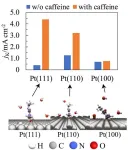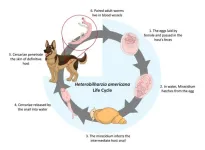(Press-News.org) With global goals set on transitioning away from fossil fuels, fuel cells stand out as a promising carbon-free energy source. Comprising an anode and a cathode separated by an electrolyte, fuel cells convert the chemical energy of fuel directly into electricity. The anode receives the fuel, while an oxidant, typically oxygen from the air, is introduced at the cathode. In a hydrogen fuel cell, hydrogen undergoes oxidation at the anode, producing hydrogen ions and electrons. The ions move through the electrolyte to the cathode, and electrons flow through an external circuit, generating electricity. At the cathode, oxygen combines with the hydrogen ions and electrons, resulting in water as the sole byproduct.
However, the presence of water affects the performance of the fuel cell. It reacts with the platinum (Pt) catalyst, forming a layer of platinum hydroxide (PtOH) on the electrode, which obstructs the efficient catalysis of the oxygen reduction reaction (ORR), leading to energy losses. To maintain efficient operation, fuel cells require a high Pt loading, which significantly increases the costs of fuel cells.
Now, in a study published in the journal Communications Chemistry on February 3, 2024, Professor Nagahiro Hoshi, along with Masashi Nakamura, Ryuta Kubo, and Rui Suzuki, all from the Graduate School of Engineering at Chiba University, Japan, have found that adding caffeine to certain platinum electrodes can increase the activity of the ORR. This discovery has the potential to reduce platinum requirements, making fuel cells more affordable and efficient.
"Caffeine, one of the chemicals contained in coffee, enhances the activity of a fuel cell reaction 11-fold on a well-defined Pt electrode of which atomic arrangement has a hexagonal structure," says Prof. Hoshi.
To assess caffeine's impact on the ORR, researchers measured current flow through platinum electrodes immersed in an electrolyte containing caffeine. These platinum electrodes had surface atoms arranged in specific directions, namely (111), (110), and (100). There was a notable improvement in the electrode's ORR activity with an increase in caffeine concentration in the electrolyte. Caffeine, when present, adsorbs onto the electrode's surface, effectively preventing hydrogen adsorption and the formation of Pt oxide on the electrode. However, the effect of the caffeine depended on the orientation of the platinum atoms on the electrode's surface.
At a caffeine molar concentration of 1 × 10−6, the ORR activity on Pt(111) and Pt(110) increased by 11 and 2.5 times, respectively, with no noticeable effect on Pt(100). To understand this difference, the researchers investigated the molecular orientation of caffeine on the electrode surface using Infrared Reflection Absorption Spectroscopy. They found that caffeine gets absorbed on Pt(111) and Pt(110) surfaces with its molecular plane perpendicular to the surface. However, on Pt(100), steric hindrances cause it to be attached with its molecular plane tilted relative to the surface of the electrode.
"The increased ORR activity of Pt(111) and Pt(110) was attributed to the decreased PtOH coverage and lower steric hindrance of the adsorbed caffeine. Conversely, for Pt(100), the effect of decreasing PtOH was counteracted by the steric hindrance of the adsorbed caffeine, and thus caffeine did not affect the ORR activity," explains Prof. Hoshi.
Unlike batteries with limited lifespans, fuel cells can generate power as long as fuel is supplied, making them suitable for various applications, including vehicles, buildings, and space missions. The proposed method has the potential to improve the designs of fuel cells and lead to their widespread use.
About Professor Nagahiro Hoshi
Nagahiro Hoshi is a Professor at the Department of Applied Chemistry and Biotechnology, Graduate School of Engineering, Chiba University, where he heads the Surface Electrochemistry Laboratory. He has published multiple papers on topics related to surface electrochemistry, surface chemistry, fuel cells, and nanoparticles. He holds a Ph.D. from Kyoto University and is a member of the Chemical Society of Japan, Electrochemical Society of Japan, International Electrochemical Society, The Japan Society of Vacuum and Surface Science, and Japan Society for Molecular Science. At Chiba University, he teaches courses in electrochemistry, quantum chemistry, chemistry basic experiments, graduate school analytical chemistry, surface physical chemistry, as well as a special course on surface electrochemistry.
END
Supercharging fuel cells with caffeine
Caffeine enhances the efficiency of fuel cells by increasing the activity of the oxygen reduction reaction
2024-03-14
ELSE PRESS RELEASES FROM THIS DATE:
Poor neighborhoods linked to elevated dementia risk and faster brain aging
2024-03-14
DURHAM, NC – Living in a poorer neighborhood is linked to accelerated brain aging and increased dementia risk early in life, regardless of income level or education, a Duke University-led study finds.
The study, which appears March 14 in Alzheimer's & Dementia: The Journal of the Alzheimer's Association, suggests that targeting disadvantaged neighborhoods for dementia prevention programs and encouraging clinicians to consider a patient’s address could help lower dementia risk.
“If you want to prevent dementia, and you’re not asking someone ...
Dog-killing flatworm discovered in Southern California
2024-03-14
UC Riverside scientists confirm, for the first time, that a potentially fatal dog parasite is present in a portion of the Colorado River that runs through California.
The parasite, Heterobilharzia americana, is a flatworm commonly referred to as liver fluke. Previously found almost exclusively in Texas and other Gulf Coast states, it has never been reported this far west. The worm can cause canine schistosomiasis, an illness that impacts the liver and intestines of dogs.
“Dogs can die from this infection, so we are hoping ...
It’s hearty, it’s meaty, it’s mold
2024-03-14
With animal-free dairy products and convincing vegetarian meat substitutes already on the market, it’s easy to see how biotechnology can change the food industry. Advances in genetic engineering are allowing us to harness microorganisms to produce cruelty-free products that are healthy for consumers and healthier for the environment.
One of the most promising sources of innovative foods is fungi – a diverse kingdom of organisms that naturally produce a huge range of tasty and nutritious ...
First gene therapy tests in whole human liver
2024-03-14
In a worldwide first-of-its-kind study published in the prestigious journal Nature Communications this week, a team of scientists from Children’s Medical Research Institute (CMRI) tested novel gene therapies in a whole human liver, with the goal of developing more effective treatments for life-threatening inherited diseases.
Gene therapy is a revolutionary approach to treating serious genetic diseases that most commonly involves replacing or repairing a faulty gene. The most efficient delivery systems today are those based on a harmless virus named adeno-associated ...
Researchers target cancer’s ability to survive at low oxygen levels
2024-03-14
Researchers at the Francis Crick Institute have shed light on how cancer cells survive in the first few hours after being cut off from a supply of oxygen.
Published today in The EMBO Journal, this finding could one day help to prevent cancer from becoming resistant to therapy.
A major use of oxygen by cells is for energy production. When oxygen supplies are low, most cells can survive because they adapt, by changing which proteins they make, to produce energy through different processes than in normal oxygen levels. This is coordinated by a protein called HIF1α, which turns on the activity of genes.
Although HIF1α ...
African American veterans with PTSD had higher risk of re-hospitalization after stroke
2024-03-14
Research Highlights:
In a review of data for more than 90,000 veterans hospitalized with stroke, African American veterans who had been previously diagnosed with post-traumatic stress disorder (PTSD) were significantly more likely to be re-hospitalized than African American veterans without PTSD.
In contrast, white veterans with PTSD were not significantly more likely to be re-hospitalized after stroke than white veterans without PTSD.
Illicit drug use and Type 2 diabetes also raised the hospital readmission risk in African American veterans ...
Researchers can reveal illegal timber exports
2024-03-14
A new method of timber analysis developed by researchers from the University of Gothenburg can confidently identify the location in which the tree was harvested. The method has been developed with the aim of combating illegal timber imports from Russia and Belarus.
Illegal logging and the associated trade in wood products is a global problem that threatens some of the world's most important ecosystems. Researchers are trying to combat this practise with a new scientific method that can reveal ...
Study shows potential for using AI tools to detect healthcare-associated infections
2024-03-14
Arlington, Va. — March 14, 2024 — A new proof-of-concept study published today in the American Journal of Infection Control (AJIC) reports that artificial intelligence (AI) technologies can accurately identify cases of healthcare-associated infections (HAI) even in complex clinical scenarios. The study, which highlights the need for clear and consistent language when using AI tools for this purpose, illustrates the potential for incorporating AI technology as a cost-effective component of routine infection surveillance programs.
According to the most recent HAI Hospital ...
ESHRE launches factsheets to highlight environmental threats to fertility and reproductive health
2024-03-14
Governments must act now to address the effects of climate change and air pollution on fertility rates and reproductive health, says a document published by the European Society of Human Reproduction and Embryology (ESHRE) today (Thursday).
The factsheets* provide comprehensive information on global warming, evidence of its impact on fertility, and calls on policymakers to promote swift prevention measures.
Priorities should be to reach net zero CO2 emissions within the next 20 years, and to keep global warming within a 1.5% increase, says the expert ...
Olympic tower construction at Teahupo’o, Tahiti could damage reef ecosystem
2024-03-14
In preparation for the 2024 Olympic surfing competition, a new judging tower is being constructed in the reef lagoon at Teahupo’o, Tahiti. Researchers from the University of Hawai‘i (UH) at Mānoa, UH Hilo, and Arizona State University and community partners in Tahiti recently published a study in Remote Sensing that assessed the potential impacts of the tower and emphasized the importance of protecting the valuable reef—both as an integral part of the ecosystem and a resource for the local community.
“We ...
LAST 30 PRESS RELEASES:
New expert guidance urges caution before surgery for patients with treatment-resistant constipation
Solar hydrogen can now be produced efficiently without the scarce metal platinum
Sleeping in on weekends may help boost teens’ mental health
Study: Teens use cellphones for an hour a day at school
After more than two years of war, Palestinian children are hungry, denied education and “like the living dead”
The untold story of life with Prader-Willi syndrome - according to the siblings who live it
How the parasite that ‘gave up sex’ found more hosts – and why its victory won’t last
When is it time to jump? The boiling frog problem of AI use in physics education
Twitter data reveals partisan divide in understanding why pollen season's getting worse
AI is quick but risky for updating old software
Revolutionizing biosecurity: new multi-omics framework to transform invasive species management
From ancient herb to modern medicine: new review unveils the multi-targeted healing potential of Borago officinalis
Building a global scientific community: Biological Diversity Journal announces dual recruitment of Editorial Board and Youth Editorial Board members
Microbes that break down antibiotics help protect ecosystems under drug pollution
Smart biochar that remembers pollutants offers a new way to clean water and recycle biomass
Rice genes matter more than domestication in shaping plant microbiomes
Ticking time bomb: Some farmers report as many as 70 tick encounters over a 6-month period
Turning garden and crop waste into plastics
Scientists discover ‘platypus galaxies’ in the early universe
Seeing thyroid cancer in a new light: when AI meets label-free imaging in the operating room
Neutrophil-to-lymphocyte ratio may aid risk stratification in depressive disorder
2026 Seismological Society of America Annual Meeting
AI-powered ECG analysis offers promising path for early detection of chronic obstructive pulmonary disease, says Mount Sinai researchers
GIMM uncovers flaws in lab-grown heart cells and paves the way for improved treatments
Cracking the evolutionary code of sleep
Medications could help the aging brain cope with surgery, memory impairment
Back pain linked to worse sleep years later in men over 65, according to study
CDC urges ‘shared decision-making’ on some childhood vaccines; many unclear about what that means
New research finds that an ‘equal treatment’ approach to economic opportunity advertising can backfire
Researchers create shape-shifting, self-navigating microparticles
[Press-News.org] Supercharging fuel cells with caffeineCaffeine enhances the efficiency of fuel cells by increasing the activity of the oxygen reduction reaction




